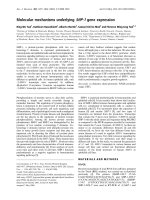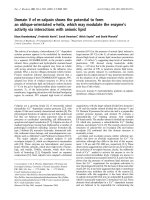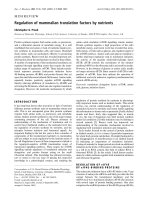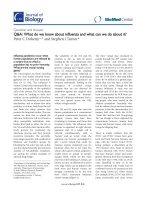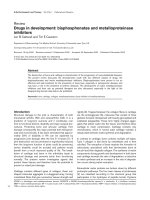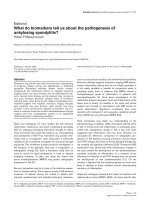Báo cáo y học: "Glucocorticoids: do we know how they work" pot
Bạn đang xem bản rút gọn của tài liệu. Xem và tải ngay bản đầy đủ của tài liệu tại đây (242.49 KB, 5 trang )
ACTH = adrenocorticotropic hormone; AP-1 = activator protein-1; CBP = CREB-binding protein; COX = cyclooxygenase; CREB = cAMP-response-
element-binding protein; ERK = extracellularly regulated kinase; GR = glucocorticoid receptor; GRE = glucocorticoid response element; IL = interleukin;
JNK = c-Jun N-terminal kinase; MAP = mitogen-activated protein; MKK = MAP kinase kinase; MKP = MAP kinase phosphatase; NF = nuclear factor.
Available online />Introduction
The anti-inflammatory action of glucocorticoid hormones
was discovered by Hench and colleagues over 50 years
ago [1]. Hench had noted that the symptoms of rheuma-
toid arthritis were often improved in pregnancy and when
a patient had jaundice, both situations in which, he rea-
soned, there was an increase in steroids in the body. The
active substances of the adrenal cortex had then recently
been isolated by Reichstein and Kendall and shown to be
steroids. It seemed possible that these might alleviate
inflammatory symptoms. Hench and his co-workers found
that small doses of cortisone dramatically improved the
symptoms of patients with rheumatoid arthritis. Hench,
Kendall, and Reichstein were jointly awarded the Nobel
Prize in physiology and medicine in 1950. Powerful syn-
thetic glucocorticoids were then developed, which,
despite their unwelcome side effects, became and remain
mainstays of anti-inflammatory and immunosuppressive
therapy.
The side effects of glucocorticoids that severely limited
their use were osteoporosis, diabetes, hypertension,
cataracts, thinning of the skin, and the characteristic
appearance of Cushing’s syndrome. They also sup-
pressed the hypothalamic–pituitary–adrenal axis and
arrested growth. Their potency in suppressing inflamma-
Commentary
Glucocorticoids: do we know how they work?
Jeremy Saklatvala
Kennedy Institute of Rheumatology Division, Faculty of Medicine, Imperial College of Science, Technology and Medicine, London, UK
Correspondence: Jeremy Saklatvala, Kennedy Institute of Rheumatology Division, Faculty of Medicine, Imperial College of Science, Technology and
Medicine, London W6 8LH, UK. Tel: +44 (0) 20 8383 4444; fax: +44 (0) 20 8563 0399; e-mail
Abstract
It is not known to what extent glucocorticoid hormones cause their anti-inflammatory actions and their
undesirable side effects by the same or different molecular mechanisms. Glucocorticoids combine
with a cytoplasmic receptor that alters gene expression in two ways. One way is dependent on the
receptor’s binding directly to DNA and acting (positively or negatively) as a transcription factor. The
other is dependent on its binding to and interfering with other transcription factors. Both mechanisms
could underlie suppression of inflammation. The liganded receptor binds and inhibits the inflammatory
transcription factors activator protein-1 and NF-κB. It also directly induces anti-inflammatory genes
such as that encoding the protein inhibitor of NF-κB. Recent work has shown that glucocorticoids
inhibit signalling in the mitogen-activated protein kinase pathways that mediate the expression of
inflammatory genes. This inhibition is dependent on de novo gene expression. It is important to
establish the significance of these different mechanisms for the various physiological effects of
glucocorticoids, because it may be possible to produce steroid-related drugs that selectively target
the inflammatory process.
Keywords: glucocorticoid, inflammation, JNK, MAP kinase, NF-κB
Received: 24 October 2001
Revisions requested: 8 November 2001
Revisions received: 22 November 2001
Accepted: 26 November 2001
Published: 21 January 2002
Arthritis Res 2002, 4:146-150
This article may contain supplementary data which can only be found
online at />© 2002 BioMed Central Ltd
(
Print ISSN 1465-9905; Online ISSN 1465-9913)
Available online />tion stimulated much investigation into their mechanism of
action. Glucocorticoids inhibit expression of many of the
genes involved in inflammatory and immune responses.
These include those encoding cytokines, chemokines,
cell-surface receptors, adhesion molecules, tissue factor,
degradative proteinases, and enzymes such as cyclo-
oxygenase (COX)-2 and inducible nitric oxide synthase,
which produce inflammatory mediators.
The glucocorticoid receptor (GR) [2] binds to specific
DNA sequences – glucocorticoid response elements
(GREs) – which may be positive or negative, either activat-
ing or repressing transcription, respectively (Fig. 1). In the
absence of ligand, the receptor is cytoplasmic and is com-
plexed with chaperones, including hsp90, hsp56
(immunophilin), and calreticulin. Upon ligand binding to
the receptor, the chaperones are shed, exposing nuclear
localisation signals. The receptor dimerises when it binds
to a GRE. Genes that are positively regulated by GREs
include those involved in gluconeogenesis, such as those
for tyrosine aminotransferase, alanine aminotransferase,
and phosphoenolpyruvate carboxykinase. Examples of
genes negatively regulated by GREs are those for pro-opi-
omelanocortin (the ACTH precursor) and prolactin. The
genes responsible for such side effects of glucocorticoids
as osteoporosis, diabetes, and hypertension are largely
unknown. Understanding the transcriptional basis of the
different physiological effects is important because it may
be possible to develop more selective agents, which
target the inflammatory process.
Glucocorticoid receptors interact with
inflammatory transcription factors
No genes responding positively to glucocorticoid hor-
mones have been identified that explain the profound sup-
pression of the inflammatory response. Furthermore,
genes of the inflammatory response lack repressing
GREs, so other explanations for the suppression of inflam-
mation have been sought [3,4]. Currently, it is thought that
a major mechanism is transcriptional interference (see
Fig. 1). Inflammatory-response genes are typically regu-
lated by the transcription factors NF-κB and activator
protein-1 (AP-1). The liganded GR interacts with AP-1
complexes (generally c-Jun/c-Fos heterodimers) and pre-
vents their transcriptional activity [3,4]. Similar tethering
occurs with NF-κB [5,6]. This interference between tran-
scription factors is reciprocal: not only can GR prevent the
function of AP-1 and NF-κB, but also AP-1 and NF-κB can
prevent transcriptional activation by GR. The physiological
significance of these mechanisms is still speculative and
the interactions between the endogenous proteins have
been difficult to demonstrate in vivo. Another possible
explanation for the functional competition between AP-1,
NF-κB, and GR is that they compete for the transcriptional
coactivators CREB-binding protein (CBP) and p300 [7,8].
However, this notion is controversial.
An additional mechanism of transcriptional interference
has been recently proposed [9]. Corticosteroid interferes
with IL-1-induced gene activation by inhibiting the histone
acetylation that loosens chromatin structure, and enables
Figure 1
Mechanisms of transcriptional regulation by glucocorticoids (adapted from M Karin [3]). Liganded GRs (ovals with patches) regulate transcription
by direct binding to DNA elements (GREs) or by binding to other transcription factors (tethering). GRE-regulated and NF-κB/AP-1-regulated
promoters are shown schematically with single binding sites; typically, there may be one or several sites. Interference with the activity of AP-1
(open and dark ovals) or NF-κB (open and dark squares) after tethering could be a direct effect on the factors’ function, or it could be an
interaction with coactivators or components of the TIC. AP-1 = activator protein-1; GR = glucocorticoid receptor; GRE = glucocorticoid response
element; NF-κB = nuclear factor-κB; TIC = transcriptional initiation complex.
Arthritis Research Vol 4 No 3 Saklatvala
access of transcription factors to their DNA binding sites
[9]. The liganded GR bound to the transcriptional com-
plexes inhibits their acetyltransferase activity. This could
be an adjunct to the mechanism of tethering of transcrip-
tion factors.
Glucocorticoids may also interfere with NF-κB activation
by a mechanism dependent upon de novo gene expres-
sion. NF-κB is sequestered in the cytoplasm with an
inhibitor, IκBα, whose degradation is induced by inflam-
matory stimuli. Production of this inhibitor is increased by
dexamethasone [10,11]. This effect is slow and its physio-
logical significance remains to be established.
Dexamethasone interferes with pathways of
mitogen-activated protein kinase
Recently, another possible mechanism for glucocorticoid
action has become apparent: dexamethasone inhibits sig-
nalling in mitogen-activated protein kinase (MAP kinase)
pathways, which are activated by inflammatory stimuli [12].
This suggests that glucocorticoids may block inflammatory
signalling at a level above transcription factor activation.
The effect, unlike transcriptional interference, requires gene
induction, possibly of a MAP kinase phosphatase (MKP),
and could inhibit both transcriptional and post-transcrip-
tional mechanisms controlled by the MAP kinases (Fig. 2).
There are three types of MAP kinase [13] and they partici-
pate in distinct phosphorylation cascades (Fig. 3). The
prototype MAP kinase is the extracellularly regulated
kinase (ERK), or p42, which is activated by many stimuli.
The other two, the c-Jun N-terminal kinase (JNK) and p38,
are very strongly activated by inflammatory stimuli such as
IL-1, tumour necrosis factor, and microbial products (e.g.
lipopolysaccharide), and by cellular stress (e.g. UV). The
MAP kinases are activated by their specific MAP kinase
kinases (MKKs) by dual phosphorylation of a motif com-
prising a threonyl and a tyrosyl residue separated by a
single amino acid. The MAP kinases phosphorylate various
substrates, including other protein kinases. At the bottom
of the cascades lie proteins controlling gene expression
and other processes.
Serving to modulate the activity of MAP kinases and to
switch off the pathways after the response to a stimulus,
are MKPs [14]. These dual-specificity phosphatases
remove phosphates from both the threonyl and tyrosyl
residues in the MAP kinase activation motifs. More than
12 of these phosphatases are known to exist, differing in
expression, subcellular localisation, and specificity for the
different MAP kinases. Since removal of phosphate from
either threonyl or tyrosyl residues inactivates the
enzymes, they may also be regulated by phospho-
Figure 2
Glucocorticoids may act (1) by transcriptional interference and (2) by inhibiting MAP kinases. The left side represents glucocorticoid (G) combining
with its receptor (GR) and inducing gene expression by binding to DNA glucocorticoid response elements (GREs). The right side shows an
inflammatory stimulus (e.g. lipopolysaccharide, IL-1, tumour necrosis factor) activating protein kinase cascades (see Fig. 3) and inducing
inflammatory response genes. (1) Transcriptional interference is due to the liganded GR directly binding the transcription factors activator protein-1
and nuclear factor-κB and inhibiting their action. (2) Glucocorticoid-induced genes, possibly MKPs, inhibit MAP kinase signalling pathways by
keeping them in the dephosphorylated state. This would inhibit both transcriptional and post-transcriptional mechanisms underlying inflammatory
gene expression. MAP = mitogen-activated protein; MKP = MAP kinase phosphatase.
serine/phosphothreonine protein phosphatases and
protein phosphotyrosine phosphatases.
The three MAP kinase pathways, in addition to the protein
kinase system that activates NF-κB by phosphorylating the
inhibitor IκB, are the major signalling systems through
which genes of the inflammatory response are activated.
Such genes are activated by several transcription factors
and typically, as mentioned earlier, NF-κB and AP-1 are
crucial. The JNK pathway is a major route for activation of
c-Jun, and therefore of AP-1 complexes. The mRNAs of
many cytokines and key regulators of the inflammatory
response are unstable by virtue of clustered AUUUA
motifs in their 3′ untranslated regions [15]. The p38 MAP
kinase pathway stabilises such mRNAs [16–21]. It is pre-
sumed that downstream kinases regulate proteins that
bind to the instability motifs.
The role of the p38 MAP kinase pathway has been eluci-
dated by studying its effect on the function of the 3′
untranslated regions of the COX-2 [20] and IL-8 mRNAs
[21]. Because dexamethasone destabilises some mRNAs,
including the mRNA of COX-2 [22], its mechanism was
investigated. It antagonised the stabilising action of the
p38 MAP kinase on the COX-2 3′ UTR. This raised the
possibility that dexamethasone was inhibiting p38 MAP
kinase. There had been reports that glucocorticoids inhib-
ited JNK activity in cells [23,24] and suppressed activity of
the ERK cascade in mast cells [25]. Treating cells with dex-
amethasone for 1–2 hours before stimulation inhibited the
activation of both p38 MAP kinase and JNK by UV light, by
IL-1, or by bacterial lipopolysaccharide [12]. We know that
this inhibition was at the level of the MAP kinase, because
dexamethasone had no effect on the p38 activator, MKK6,
and the inhibition could be circumvented by transfecting an
active mutant of the substrate of p38, the MAP kinase-acti-
vated protein kinase-2 [12]. The effect of dexamethasone
on the p38 MAP kinase was dependent upon GR and de
novo mRNA synthesis.
An explanation for these findings is that steroids induce a
protein phosphatase that keeps the p38 MAP kinase (and
JNK) in the dephosphorylated state. Alternatively, the
steroid could be inducing a molecule that inhibits the
MKKs. It will be interesting to know the basis of the MAP
kinase inhibition, its dependence on GRE-regulated
genes, and its importance in inflammation relative to the
mechanism of transcriptional interference.
Available online />Figure 3
The MAP kinase cascades. This highly simplified scheme shows the three major MAP kinase pathways of mammalian cells. The MAP kinases are
ERK, JNK, and p38. A few downstream substrates are shown. ATF = activating transcription factor; cPLA
2
= cytosolic phospholipase A
2
; CREB =
cAMP-response-element-binding protein; ERK = extracellularly regulated kinase; JNK = c-Jun N-terminal kinase; LPS = lipopolysaccharide;
MAP = mitogen-activated protein; MAPKAPK = MAP kinase-activated protein kinase; MKK = MAP kinase kinase; MKKK = MAP kinase kinase
kinase; TNF = tumour necrosis factor.
Arthritis Research Vol 4 No 3 Saklatvala
Note added in proof
Glucocorticoid increasing expression of MKP-1 has
recently been reported by Kassel et al. [26].
Acknowledgements
The author is grateful to Mrs Suzie Johns for preparation of the manu-
script, to the many authors whose work has not been directly cited in
this short review, and to the Arthritis Research Campaign and the
Medical Research Campaign for financial support.
References
1. Hench PS, Slocumb CH, Barnes AR, Smith HL, Polley HF,
Kendall EC: The effect of a hormone of the adrenal cortex, 17-
hydroxy-11-dehydrocorticosterone (compound E), on the
acute phase of rheumatic fevers. Proceedings of the Staff
Meetings of the Mayo Clinic 1949, 24-277-297.
2. Beato M, Truss M, Chavez S: Control of transcription by steroid
hormones. Ann N Y Acad Sci 1996, 784:93-123.
3. Karin M: New twists in gene regulation by glucocorticoid
receptor: is DNA binding dispensable? Cell 1998, 93:487-490.
4. Newton R: Molecular mechanisms of glucocorticoid action:
what is important? Thorax 2000, 55B, 603-613.
5. Ray A, Prefontaine KE: Physical association and functional
antagonism between the p65 subunit of transcription factor
NF-kappa B and the glucocorticoid receptor. Proc Natl Acad
Sci U S A 1994, 91:752-756.
6. Scheinman RI, Gualberto A, Jewell CM, Cidlowski JA, Baldwin AS
Jr: Characterization of mechanisms involved in transrepres-
sion of NF-kappa B by activated glucocorticoid receptors. Mol
Cell Biol 1995,15:943-953.
7. Kamei Y, Xu L, Heinzel T, Torchia J, Kurokawa R, Gloss B, Lin SC,
Heyman RA, Rose DW, Glass CK, Rosenfeld MG: A CBP inte-
grator complex mediates transcriptional activation and AP-1
inhibition by nuclear receptors. Cell 1996, 85:403-414.
8. Sheppard KA, Phelps KM, Williams AJ, Thanos D, Glass CK,
Rosenfeld MG, Gerritsen ME, Collins T: Nuclear integration of
glucocorticoid receptor and nuclear factor-kappaB signaling
by CREB-binding protein and steroid receptor coactivator-1. J
Biol Chem 1998, 273:29291-29294.
9. Ito K, Barnes PJ, Adcock IM: Glucocorticoid receptor recruit-
ment of histone deacetylase 2 inhibits interleukin-1beta-
induced histone H4 acetylation on lysines 8 and 12. Mol Cell
Biol 2000, 20:6891-6903.
10. Scheinman RI, Cogswell PC, Lofquist AK, Baldwin AS Jr: Role of
transcriptional activation of I kappa B alpha in mediation of
immunosuppression by glucocorticoids. Science 1995,
270:283-286.
11. Auphan N, DiDonato JA, Rosette C, Helmberg A, Karin M:
Immunosuppression by glucocorticoids: inhibition of NF-
kappa B activity through induction of I kappa B synthesis.
Science 1995, 270:286-290.
12. Lasa M, Brook M, Saklatvala J, Clark AR: Dexamethasone
destabilizes cyclooxygenase 2 mRNA by inhibiting mitogen-
activated protein kinase p38. Mol Cell Biol 2001, 21:771-80.
13. Garrington TP, Johnson GL: Organization and regulation of
mitogen-activated protein kinase signaling pathways. Curr
Opin Cell Biol 1999, 11:211-218.
14. Keyse SM: Protein phosphatases and the regulation of
mitogen-activated protein kinase signalling. Curr Opin Cell
Biol 2000, 12:186-92.
15. Shaw G, Kamen R: A conserved AU sequence from the 3
′′
untranslated region of GM-CSF mRNA mediates selective
mRNA degradation. Cell 1986, 46:659-667.
16. Ridley SH, Dean JL, Sarsfield SJ, Brook M, Clark AR, Saklatvala J:
A p38 MAP kinase inhibitor regulates stability of interleukin-1-
induced cyclooxygenase-2 mRNA. FEBS Lett 1998, 439:75-80.
17. Dean JL, Brook M, Clark AR, Saklatvala J: p38 mitogen-activated
protein kinase regulates cyclooxygenase-2 mRNA stability
and transcription in lipopolysaccharide-treated human mono-
cytes. J Biol Chem 1999, 274:264-269.
18. Miyazawa K, Mori A, Miyata H, Akahane M, Ajisawa Y, Okudaira H:
Regulation of interleukin-1beta-induced interleukin-6 gene
expression in human fibroblast-like synoviocytes by p38
mitogen-activated protein kinase. J Biol Chem 1998, 273:
24832-24838.
19. Brook M, Sully G, Clark AR, Saklatvala J: Regulation of tumour
necrosis factor alpha mRNA stability by the mitogen-activated
protein kinase p38 signalling cascade. FEBS Lett 2000, 483:
57-61.
20. Lasa M, Mahtani KR, Finch A, Brewer G, Saklatvala J, Clark AR:
Regulation of cyclooxygenase 2 mRNA stability by the
mitogen-activated protein kinase p38 signaling cascade. Mol
Cell Biol 2000, 20:4265-4274.
21. Winzen R, Kracht M, Ritter B, Wilhelm A, Chen CY, Shyu AB,
Muller M, Gaestel M, Resch K, Holtmann H: The p38 MAP kinase
pathway signals for cytokine-induced mRNA stabilization via
MAP kinase-activated protein kinase 2 and an AU-rich region-
targeted mechanism. Embo J 1999, 18:4969-4980.
22. Ristimaki A, Narko K, Hla T: Down-regulation of cytokine-
induced cyclo-oxygenase-2 transcript isoforms by dexam-
ethasone: evidence for post-transcriptional regulation.
Biochem J 1996, 318:325-331.
23. Swantek JL, Cobb MH, Geppert TD: Jun N-terminal
kinase/stress-activated protein kinase (JNK/SAPK) is
required for lipopolysaccharide stimulation of tumor necrosis
factor alpha (TNF-alpha) translation: glucocorticoids inhibit
TNF-alpha translation by blocking JNK/SAPK. Mol Cell Biol
1997, 17:6274-6282.
24. Caelles C, Gonzalez-Sancho JM, Munoz A: Nuclear hormone
receptor antagonism with AP-1 by inhibition of the JNK
pathway. Genes Dev 1997, 11:3351-3364.
25. Rider LG, Hirasawa N, Santini F, Beaven MA: Activation of the
mitogen-activated protein kinase cascade is suppressed by
low concentrations of dexamethasone in mast cells. J
Immunol 1996, 157:2374-2380.
26. Kassel O, Sancono A, Kratzschmar J, Kreft B, Stassen M, Cato AC:
Glucocorticoids inhibit MAP kinase via increased expression
and decreased degradation of MKP-1. EMBO J 2001,
20:7108-7116.


